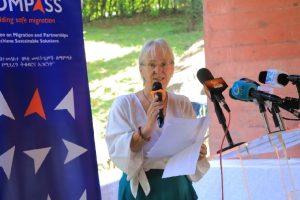
DUBTI – Despite its abundant potential to produce wheat Ethiopia still spends a lot of money to import the crop to provide for local consumption.
But with the introduction of the lowland wheat initiative, import substitution and sustainability of local supplies across Awash, Wabeshebelle and Omo will be expected to satisfy the need of the society and to be exported by 2025.
The Ethiopian government announced recently that the country should become wheat self-sufficient over the next four years in 2023. Despite a record harvest of 4.6 million metric tons in 2017, Ethiopia imported 1.5 million tons of wheat the same year, costing US$600 million.
Population growth, continuous economic growth and urbanization over the last decade have led to a rapid change in Ethiopian diets, and the wheat sector cannot keep up with the growing demand for food in Ethiopia.
Accordingly, the institute in collaboration with other stakeholders says it has set a target of becoming fully self-sufficient in wheat production over the next four years.
The institute said several works have been started to modernize Ethiopia’s agricultural system and boost production through employing technology.
The majority of Ethiopia’s 4.2 million wheat farmers cultivate this cereal on an average of 1.2 hectare holdings, with three quarters produced in Arsi, Bale and Shewa areas. Most prepare the land and sow with draft animal power equipment and few inputs, dependent on erratic rainfall without complementary irrigation and modern machineries which helps to double productivity.
EIAR Researcher at Werer Research Institute Center, Nigussie Abebe told The Ethiopian Herald that in addition to better access to improved seeds and necessary inputs, better agronomic research practices are needed. Scaling up the use of irrigation would certainly increase a wheat yield which is supported by research and technology.
Knowing the optimal water needs of the crop in irrigation areas for each agro-ecological zone and the underlying drainage system is crucial. Otherwise, farmers are at risk of losing their land for nothing due to an accumulation of salt in the area, said Nigussie.
Afar region Dubti, Asaita and Afambo Wheat Demonstration Cluster Coordinator at EIAR, Zeray Zeleke for his part said that previously the area infested by alien vegetation called Prosopis Juliflora, a pervasive herb that hinders the society’s life at all.
This tree spreads fast and is dangerous for the health of livestock. By clearing this tree and turning the areas with this productive wheat which is harvested in less than four week is an advantage for the society.
EIR General Director Dr. Mandefro Nigussie said that this initiative is being implemented in Awash, Wabeshebelle and Omo basins, locations where wheat production was not previously practiced.
“Through employing various methods like irrigation, intensification, acid soil management and vertisol method we can definitely ensure and satisfy the needs of the society at large not only lowland areas.
Mechanization could also boost Ethiopian wheat production and provide youth with new job opportunities. Lowland wheat production was successfully demonstrated in Awash and Omo basins currently,” he added.
Accordingly, nation plans to harvest more than 755,000 million quintals this year. In addition to wheat, the Ministry will give a due attention to boosting the productivity of sugar as well.
Abdalla Adan is among the beneficiary in Afambo irrigation project of Afar region in Asaita. He said that previously the area is covered by prosopis juliflora.
“We don’t know how to produce wheat from such kind of land. From the very beginning all society expects wheat from government and even we don’t even think to produce wheat or other cereals from such kind of land since all our life is pastoralist,” he explained.
Zeray stated that, the implementation of the lowland wheat project will contribute to achieving Ethiopia’s import substitution efforts in the long term, and will also have an immediate positive impact on improving the livelihoods of the farmers and pastoralists residing in the implementation areas. Beyond this the project turns the society from pastoralist to farming system to be independent from awaiting government support, he indicated.
At full implementation, the lowland wheat initiative will cover more than 150,000 hectares of land across the three basins and is expected to produce over 6 million quintals of wheat. Combined with the existing support to increase production and productivity in the Ethiopian highlands, this lowland wheat project will make significant contributions towards achieving Ethiopia’s plan to gradually replace importation as laid out in the country’s import substitution strategy..
The Ethiopian Herald February 1/2020
BY HAILE DEMEKE





